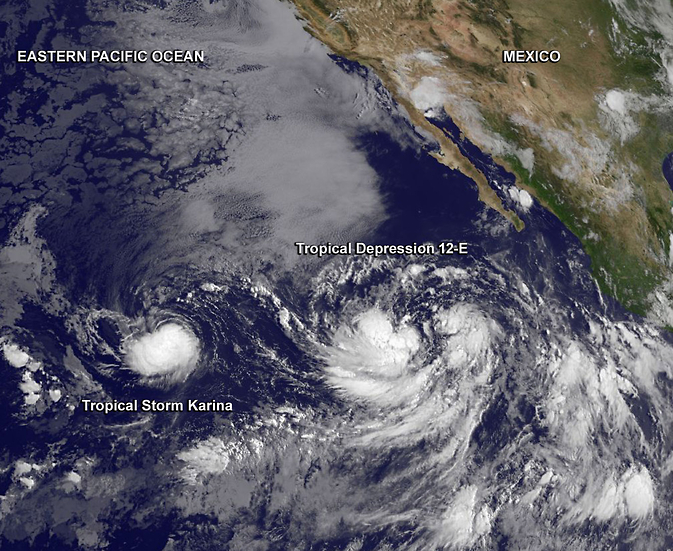Twelfth Tropical Depression Appears Huge on Satellite Imagery

On August 18, NOAA's GOES-West satellite captured an image of tiny Tropical Storm Karina followed to the east by the massive Tropical Depression12-E. Image Credit: NASA/NOAA GOES Project
Tropical cyclones are usually a couple of hundred miles in diameter. The average size of a tropical cyclone is around 304 nautical miles (350 miles/600 km) in diameter.
The National Hurricane Center noted on August 18 at 11 a.m. EDT that Tropical Depression 12-E was at least 800 nautical miles (920.6 miles/1,482 km) in diameter! By comparison, Tropical Storm Karina is a couple of hundred miles in diameter.
At 11 a.m. EDT on August 18, tropical-storm-force winds extended outward up to 80 miles (130 km) from Karina's center.
NASA/NOAA's GOES Project at the NASA Goddard Space Flight Center in Greenbelt, Maryland generates visible and infrared satellite imagery of the Eastern and Central Pacific Oceans from NOAA's GOES-West and GOES-East satellites.
On August 18, at 11 a.m. EDT (1500 UTC) the center of Tropical Depression Twelve-e was located near latitude 16.7 north and longitude 117.7 west, that's about 665 miles (1,065 km) southwest of the southern tip of Baja California.
Maximum sustained winds are near 35 mph (55 kph), and the depression is expected to become a tropical storm late on August 18.
The depression is moving toward the west-northwest near 8 mph (13 kph) and the National Hurricane Center expects a turn toward the northwest followed by a turn north on August 19.
Text credit: Rob Gutro
NASA's Goddard Space Flight Center
Media Contact
More Information:
http://www.nasa.gov/content/goddard/12e-eastern-pacific-ocean/All latest news from the category: Earth Sciences
Earth Sciences (also referred to as Geosciences), which deals with basic issues surrounding our planet, plays a vital role in the area of energy and raw materials supply.
Earth Sciences comprises subjects such as geology, geography, geological informatics, paleontology, mineralogy, petrography, crystallography, geophysics, geodesy, glaciology, cartography, photogrammetry, meteorology and seismology, early-warning systems, earthquake research and polar research.
Newest articles

Sea slugs inspire highly stretchable biomedical sensor
USC Viterbi School of Engineering researcher Hangbo Zhao presents findings on highly stretchable and customizable microneedles for application in fields including neuroscience, tissue engineering, and wearable bioelectronics. The revolution in…

Twisting and binding matter waves with photons in a cavity
Precisely measuring the energy states of individual atoms has been a historical challenge for physicists due to atomic recoil. When an atom interacts with a photon, the atom “recoils” in…

Nanotubes, nanoparticles, and antibodies detect tiny amounts of fentanyl
New sensor is six orders of magnitude more sensitive than the next best thing. A research team at Pitt led by Alexander Star, a chemistry professor in the Kenneth P. Dietrich…





















